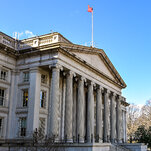The United States narrowly avoided a default when President Biden signed legislation on Saturday that allowed the Treasury Department, which was perilously close to running out of cash, permission to borrow more money to pay the nation’s bills. Now, the Treasury is starting to build up its reserves and the coming borrowing binge could present complications that rattle the economy. The government is expected to borrow around $1 trillion by the end of September, according to estimates by multiple banks.
That steady state of borrowing is set to pull cash from banks and other lenders into Treasury securities, draining money from the financial system and amplifying the pressure on already stressed regional lenders. To lure investors to lend such huge amounts to the government, the Treasury faces rising interest costs. Given how many other financial assets are tied to the rate on Treasuries, higher borrowing costs for the government also raise costs for banks, companies and other borrowers, and could create a similar effect to roughly one or two quarter-point rate increases from the Federal Reserve, analysts have warned.
“The root cause is still very much the whole debt ceiling standoff,” said Gennadiy Goldberg, an interest rate strategist at TD Securities. Some policymakers have indicated that they may opt to take a break from raising rates when the central bank meets next week, in order to assess how policy has so far impacted the economy. The Treasury’s cash rebuild could undermine that decision, because it would push borrowing costs higher regardless.
That could in turn exacerbate worries among investors and depositors that flared up in the spring over how higher interest rates had eroded the value of assets held at small and medium sized banks. The deluge of Treasury debt also amplifies the effects of another Fed priority: the shrinking of its balance sheet. The Fed has curtailed the number of new Treasuries and other debt that it buys, slowly letting old debt roll-off and already leaving private investors with more debt to digest.
“The potential hit to the economy once Treasury goes to market selling that much debt could be extraordinary,” said Christopher Campbell, who served as assistant Treasury secretary for financial institutions from 2017 to 2018. “It’s difficult to imagine Treasury going out and selling what could be $1 trillion of bonds and not have that have an impact on borrowing costs. ” The cash balance at the Treasury Department’s general account fell below $40 billion last week as lawmakers raced to reach an agreement to increase the nation’s borrowing cap.
Mr. Biden on Saturday signed legislation that suspended the $31. 4 trillion debt limit until January 2025.
For months, Treasury Secretary Janet L. Yellen had been using accounting maneuvers known as extraordinary measures to delay a default. Those included suspending new investments in retirement funds for postal workers and civil servants.
Restoring those investments is essentially a simple accounting fix, but refilling the government’s cash coffers is more complicated. The Treasury Department said on Wednesday that it hoped to borrow enough to rebuild its cash account to $425 billion by the end of June. It will need to borrow much more than that to account for planned spending, analysts said.
“The supply floodgates are now open,” said Mark Cabana, an interest rate strategist at Bank of America. A Treasury Department spokesman said that when making decisions on issuing debt, the department carefully considered investor demand and market capacity. In April, Treasury officials started surveying key market players about how much they thought the market could absorb after the debt-limit standoff was resolved.
The Federal Reserve Bank of New York asked large banks for their estimates of what they expected to happen to bank reserves and borrowing from certain Fed facilities in the next months. The spokesman added that the department had managed similar situations before. Notably, after a bout of debt-limit wrangling in 2019, the Treasury Department rebuilt its cash pile over the summer, contributing to factors that drained reserves from the banking system and upended the market’s plumbing, prompting the Fed to intervene to stave off a worse crisis.
One of the things the Fed did was establish a program for repurchase agreements, a form of financing with Treasury debt posted as collateral. That backstop could provide a safety net to banks short on cash from lending to the government, though its use was widely seen in the industry as a last resort. A similar but opposite program, which doles out Treasury collateral in exchange for cash, now holds over $2 trillion, mostly from money market funds that have struggled to find attractive, safe investments.
This is viewed by some analysts as money on the sidelines that could flow into the Treasury’s account as it offers more attractive interest rates on its debt, reducing the impact of the borrowing spree. But the mechanism by which the government sells its debt, debiting bank reserves held at the Fed in exchange for the new bills and bonds, could still test the resilience of some smaller institutions. As their reserves decline, some banks may find themselves short on cash, while investors and others may not be willing to lend to institutions they see as troubled, given recent worries about some corners of the industry.
That could leave some banks reliant on another Fed facility, set up at the height of this year’s banking turmoil, to provide emergency funding to deposit taking institutions at relatively high cost. “You may see one or two or three banks caught unprepared and suffer the consequences, starting a daisy chain of fear that can permeate through the system and create trouble,” Mr. Goldberg of TD Securities said.
.
From: nytimes
URL: https://www.nytimes.com/2023/06/07/business/economy/debt-ceiling-borrowing-binge.html



